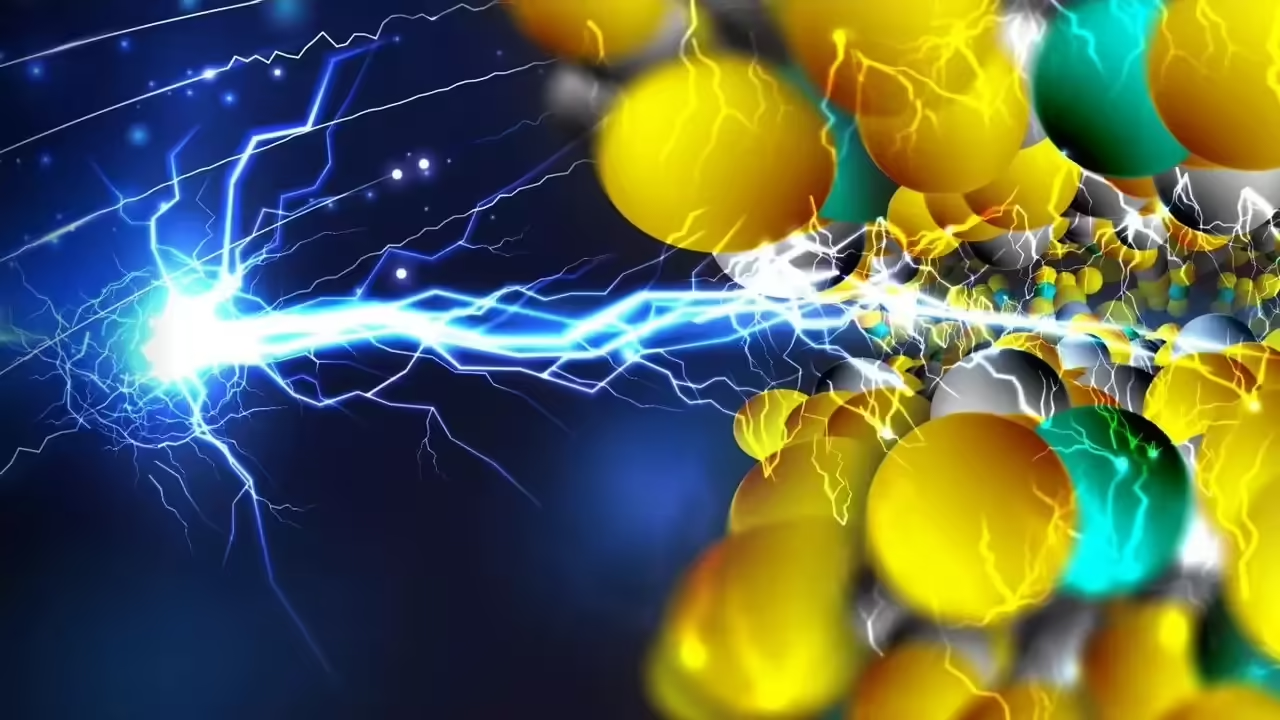
In the vast field of quantum physics, metals stand out as stellar performers in electrical conduction, displaying fascinating behavior rooted in the subatomic level.
Electrical Conductivity in Metals: Quantum Ballet of Electrons
The Ballet of Quantum Electrons: A Brief Explanation
Inside a metal, electrons engage in a genuine quantum ballet. The band theory describes how certain electrons, known as conduction electrons, can move freely in the metal’s crystalline structure, while others, valence electrons, are more bound to individual atoms. This coordinated movement of conduction electrons allows efficient transfer of electric charge along the metal.
Understanding this phenomenon not only immerses us in the wonders of quantum physics but also enables us to appreciate the importance of metals as essential electrical conductors in our daily lives.
Technological Implications: Beyond the Quantum Frontier
The relevance of understanding electrical conductivity in metals goes beyond academia, reaching technological applications that drive our modern world. From electronic devices to energy transmission systems, the ability of metals to conduct electricity plays a crucial role in the development and improvement of various technologies.
In the electronic industry, optimizing conductive materials based on quantum principles has led to significant advancements. More efficient circuits, smaller devices, and more powerful technologies are just some of the direct consequences of our understanding of electrical conductivity in metals.
Similarly, in the field of energy infrastructures, knowledge of these quantum processes has allowed the design of more efficient and sustainable electrical transmission systems, contributing to the construction of a smarter electrical grid adaptable to the demands of contemporary society.
Fundamental Properties of Metals: Pillars of Electrical Conductivity
Metals, with their unique characteristics, are fundamental to our understanding of electrical conductivity. We will explore key physical properties that define these elements and highlight their distinctive ability to conduct electricity, especially through the crucial presence of free electrons.
Crystalline Structure: Harmonious Atomic Order
Metals exhibit a unique crystalline structure in which atoms are arranged in an ordered and repetitive pattern. This arrangement facilitates the mobility of electrons in the crystalline network, laying the foundation for their electrical conductivity. The regularity of this structure allows electrons to move easily through the metal, contributing to its efficient electrical conduction.
Electron Density: Abundance of Charge Carriers
An essential physical property of metals is their high electron density. Electrons in the outer layer of metal atoms have relative freedom to move, creating an electron “cloud” that extends along the crystalline structure. This abundance of mobile electrons acts as charge carriers, facilitating electrical conduction by allowing the free flow of current.
Metallic Bonding: Collective Strength
Metallic bonding is a force that holds atoms together in the crystalline structure. Unlike ionic or covalent bonds, metals collectively share electrons. This bonding allows the formation of a “pool” of free electrons that can move between metal atoms, contributing to the mobility of electric charge through the material.
Electronic Mobility: Quantum Ballet in Action
Electronic mobility in metals is an intrinsic property related to the ability of electrons to move relatively freely. The band theory explains how certain electrons, known as conduction electrons, can easily move through the crystalline structure, providing an efficient means of electrical conduction.
Free Electrons: Architects of Conductivity
One of the standout features defining electrical conductivity in metals is the presence of free electrons. These electrons are not strongly bound to individual atoms and can therefore move freely through the material. The existence of free electrons facilitates the transfer of electric charge, making metals excellent conductors.
Classical Theory vs. Quantum Phenomena: Challenging Limits in Metal Electrical Conductivity
Classical Theory of Electrical Conductivity in Metals
The classical theory of electrical conductivity in metals, based on traditional electromagnetic concepts, provides an initial but limited description of this fundamental phenomenon. According to this perspective, electrons in a metal would behave like classical particles in motion, following well-defined paths around atomic nuclei. This classical approach assumes a direct relationship between electron velocity and electric current, as described in a Newtonian view of motion.
However, the classical theory faces challenges in explaining specific phenomena observed in the electrical conductivity of metals. One of the main obstacles is the discrepancy between classical predictions and experimental observations, especially at microscopic scales. The classical theory cannot account for the high electrical conductivity observed in metals or explain quantum phenomena, such as superposition of states and quantum interference.
Limitations of Classical Theory: Delving into the Quantum
The limitations of the classical theory become more evident when considering quantum phenomena inherent in the electrical conductivity of metals. One key aspect challenging the classical view is the presence of free electrons and their quantum behavior in the crystalline structure of metals.
Quantum Superposition: Beyond Defined Paths
In the quantum world, electrons do not follow predictable classical paths. Quantum superposition allows electrons to exist in multiple states simultaneously, challenging the classical notion of well-defined paths. This has a significant impact on conductivity, as electrons can participate in a quantum ballet, moving coordinately rather than following predictable paths.
Free Electrons: A Crucial Quantum Phenomenon
Quantum theory reveals that some electrons in metals can behave as free particles, detaching from individual atoms. These free electrons contribute significantly to electrical conductivity by moving unrestrictedly through the crystalline structure. This quantum phenomenon is essential to explaining the high conductivity observed in metals and goes beyond classical understanding based on particles entirely bound to atoms.
Quantum Interference: Modeling Conductivity
Another relevant quantum phenomenon is quantum interference, where the probability waves of electrons overlap and can interfere constructively or destructively. This complex behavior contributes to the formation of energy bands in the band theory, an essential quantum explanation for understanding how certain electrons contribute to electrical conduction while others remain more bound.
Quantum Effects on Conductivity: Between Interference and Quantum Tunneling
Quantum phenomena, such as electronic interference and quantum tunneling, play a crucial role in the electrical conductivity of materials. These effects, although strange from a classical perspective, are essential for understanding the rich variety of behaviors observed at the quantum level. Below, we explore how electronic interference and quantum tunneling affect electrical conductivity, along with illustrative examples.
Electronic Interference:
Quantum interference is a phenomenon in which the probability waves associated with quantum particles can combine constructively or destructively. In the context of electrical conductivity, this has a notable impact:
Effect on Conductivity: When electrons move through a conductor, their probability waves can interfere with each other. If the waves interfere constructively, they strengthen each other, increasing the probability of finding an electron in a particular region. On the other hand, destructive interference weakens probabilities, creating regions where the probability of finding an electron is low.
Example: Consider a thin conductor where electrons have multiple possible routes to travel from one end to the other. Quantum interference can make some of these routes more probable than others, affecting the total resistance of the conductor and, consequently, electrical conductivity.
Quantum Tunneling:
Quantum tunneling is a phenomenon in which a quantum particle can pass through an energy barrier, even when classically it would not have enough energy to overcome it.
Effect on Conductivity: In the context of electrical conductivity, quantum tunneling allows electrons to traverse potential barriers that, according to classical physics, would be impassable due to a lack of sufficient energy.
Example: Imagine a semiconductor material with an energy barrier. In classical conditions, electrons could not overcome the barrier if their energy is lower than the barrier’s height. However, through quantum tunneling, some electrons can “jump” through the barrier, contributing to electric current and affecting the material’s conductivity.
Combination of Effects: In some cases, electronic interference and quantum tunneling can interact in a complex way, giving rise to even more fascinating quantum phenomena in the electrical conductivity of materials.
Example: In nanoscale devices, where dimensions are comparable to the electron wavelength, interference and quantum tunneling can intertwine. This can lead to novel quantum effects significantly affecting conductivity, such as the Aharonov-Bohm ring phenomenon.
Technological Applications and Advances: Unleashing the Potential of Electrical Conductivity in Metals
Practical Applications of Understanding Electrical Conductivity in Metals:
Modern Electronics:
Microprocessors and Integrated Circuits: Understanding electrical conductivity in metals is essential for the design and operation of microprocessors and integrated circuits, the backbone of modern electronics.
Communication Technologies:
Optical Fibers and Connectivity: Metals, such as copper, play a fundamental role in the infrastructure of communication networks, such as data transmission through cables and optical fibers.
Generation and Transmission of Energy:
Efficient Electrical Conductors: Electrical conductivity in metals contributes to efficiency in transmitting electrical energy through cables and transmission lines, minimizing energy losses.
Electromobility:
Batteries and Storage Systems: Metals play a key role in the development of batteries for electric vehicles and energy storage systems, driving the transition to electromobility.
Detection Technologies:
Sensors and Detection Devices: Electrical conductivity in metals is used in the manufacturing of sensors and detection devices, from temperature sensors to biomedical devices.
Technological Advances Based on These Concepts:
Nanotechnology and Quantum Devices:
Quantum Transistors: Advances in understanding quantum conductivity have led to the development of quantum transistors and nanoscale devices, opening new possibilities in the miniaturization of electronics.
Quantum Computing:
Superconducting Qubits: Superconductivity, a phenomenon intimately related to conductivity in metals, is essential for the development of superconducting qubits, driving research in quantum computing.
Innovative Conductive Materials:
Conductive Graphite and Nanomaterials: Advances in the synthesis and understanding of nanomaterials, such as graphene, have led to the exploration of highly efficient and lightweight conductors with applications in flexible electronics and emerging devices.
Renewable Energies:
Solar Cells and Energy Capture Technologies: Research in electrical conductivity has contributed to the development of more efficient solar cells and energy capture technologies, promoting the adoption of renewable energy sources.
Flexible Electronics:
Flexible Circuits and Foldable Screens: Understanding conductivity in flexible materials has led to the development of flexible electronic circuits and foldable screens used in modern electronic devices.







